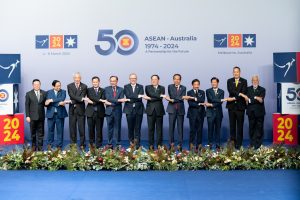The Australian government yesterday announced an A$2 billion ($1.3 billion) fund to boost trade and investment in Southeast Asia, as leaders from the region gathered for a special Association of Southeast Asian Nations (ASEAN) summit in Melbourne.
Prime Minister Anthony Albanese announced the fund to a meeting of Australian and Southeast Asian CEOs, along with a further suite of economic initiatives, declaring that Australia “is open for business, tourism and trade.” He told the gathering that his government is pursuing “the most significant upgrade of Australia’s economic engagement with ASEAN for a generation.”
“The government I lead has made it clear: more than any other region, Southeast Asia is where Australia’s future lies,” Albanese said, according to speech notes distributed to the media ahead of the meeting.
According to a statement released by Albanese’s office yesterday, this “package of focused initiatives” represents the next phase of the government’s response to recommendations in the Southeast Asia Economic Strategy that it unveiled last year.
The $2 billion Southeast Asia Investment Financing Facility will provide loans, guarantees, equity, and insurance for projects that would boost Australian trade and investment in Southeast Asia, “particularly in support of the region’s clean energy transition and infrastructure development.” The facility will be managed by Export Finance Australia.
Albanese announced a further $140 million over four years to extend the existing Partnerships for Infrastructure scheme, which is designed “to drive sustainable, inclusive, and resilient growth through quality infrastructure” in Southeast Asian countries. The government has also promised to improve access to long-term business visas for Southeast Asian nationals, and establish regional technology “landing pads” in Jakarta and Ho Chi Minh City, to “provide on-the-ground support for Australian businesses to boost technology services exports to Southeast Asian markets.” A similar “landing pad” was established in Singapore in 2017.
Australia’s two-way trade with ASEAN member states exceeded A$178 billion ($115 billion) in 2022, according to the statement from Albanese’s office, while two-way investment between the two regions amounted to A$307 billion ($198 billion). But Canberra clearly sees additional untapped potential in the economic relations between Australia and the 10 nations of ASEAN, which is collectively the world’s fourth-largest economy. In an interview with Sky News yesterday, Treasurer Jim Chalmers said that the government hoped to “turbocharge these relationships with ASEAN countries.”
The investment facility is one of the main “deliverables” that Australia has announced during the ASEAN-Australia Special Summit, which opened in Melbourne on Tuesday and comes to a close today. The announcement will no doubt be welcomed by Australia’s business community, especially those firms engaged in climate-adjacent sectors of the economy. As Bran Black of the Business Council of Australia, told SBS News, “What does it mean for Australia? Well, it’s very clear. It’s more jobs, it’s more opportunity, and it’s more growth.”
However, the Australian government’s focus on economics and business – these occupied two of the four main areas of focus for the Summit – has been overshadowed by tensions in the South China Sea, where Chinese and Philippine coast guard vessels once again collided yesterday in contested waters. The incident took place close to Second Thomas Shoal yesterday morning, as the China Coast Guard sought to block the resupply of Philippine troops stationed in a rusting warship at the shoal. Manila later offered further details about the incident, sharing footage of a Chinese high-pressure water cannon smashing the windshield of a Philippines supply boat. It said that the confrontation near Second Thomas Shoal injured four Filipino crewmembers, and caused minor hull damage to a Philippine Coast Guard vessel.
Australia has offered rhetorical support for the Philippines over the past year, as it has faced increasingly frequent and intense Chinese incursions into its exclusive economic zone.
In a speech to a maritime security forum on the sidelines of the Summit on Tuesday, Australian Foreign Minister Penny Wong expressed concern about “destabilizing, provocative and coercive actions” in the South China Sea, “including unsafe conduct at sea and in the air and militarization of disputed features.” She also announced A$64 million ($41.8 million) in Australian funding that will be used to “expand Australia’s maritime cooperation with regional partners and contribute to the security and prosperity of the region,” a statement from Wong’s office said.
However, economic imperatives will likely inhibit a strong Australian response. While trade with ASEAN is booming, China remains the country’s largest trading partner, amounting to nearly 27 percent of its total two-way trade in 2021-2022, according to the Department of Foreign Affairs and Trade. As such, it is likely to tread warily, given the efforts that Albanese’s government has made to patch up its relationship with Beijing, after China imposed a range of trade restrictions on Australia during the COVID-19 pandemic.
Instead of going all-in on security to support South China Sea claimant states like the Philippines and Vietnam, Canberra is instead hedging against China by quietly fortifying its relationships with long-standing partners further afield. These include the three other members of the Quad – Japan, the United States, and India, and AUKUS, the trilateral security pact that it established with the U.S. and the United Kingdom in 2021.
As Nick Bisley, a professor at La Trobe University in Melbourne, told CNN, Australia’s view of foreign policy remained “overly anxious about China,” which accounted for the caution in most of Canberra’s statements about maritime tensions in the South China Sea.
“We don’t like what China does, but we’re not going to put ourselves in harm’s way,” he said.

































